Experimental and Numerical Investigation for Seismic Performance of a Large-Scale LNG Storage Tank Structure Model
Abstract
:1. Introduction
2. Shaking Table Test of LNG Storage Tank Model
2.1. Test Model
2.2. Seismic Wave Selection
2.3. Design of Lead-Core Rubber Bearing
3. Analysis of Test Results
3.1. Natural Vibration Characteristics
- (1)
- After seismic isolation measures are taken, the natural vibration frequency of the tank model is significantly reduced. Before the seismic wave is applied, along the X-direction, the frequencies of the seismic storage tank and the seismic isolation tank are 16.8 Hz and 7.0 Hz. After the seismic isolation, the frequency of the storage tank decreases by 9.5 Hz, with a decrease of 56.5%. Along the Y-direction, the frequencies of the seismic storage tank and the isolation storage tank are 16.1 Hz and 7.0 Hz, and the frequency of the storage tank is reduced by 9.1 Hz after isolation, with a decrease of 56.5%. This shows that the isolation bearing has the same effect on the natural vibration frequency of the tank in the X- and Y-directions.
- (2)
- With the increase of peak acceleration of the seismic wave, the natural vibration frequency of the seismic storage tank and the seismic isolation storage tank decreases gradually. This indicates that the tank was damaged, and that the damage was progressive. After the test, along the X-direction, the natural vibration frequencies of the seismic storage tank and the isolation storage tank decreased by 1.8 Hz and 0.9 Hz, respectively; along the Y-direction, the natural vibration frequencies of the seismic storage tank and the isolation storage tank decreased by 2.5 Hz and 1 Hz, respectively. This indicates that the damage degree of the isolation storage tank is smaller than that of the seismic storage tank.
3.2. Acceleration Response
- (1)
- The acceleration of the seismic storage tank approximately increases linearly along the direction of height, and the acceleration will change abruptly at the dome position, which indicates that the lateral stiffness of the dome position is much lower than that of the tank wall. After the seismic isolation measures are taken, acceleration response of the storage tank is significantly reduced. In the direction of seismic wave action, the isolation effect is particularly obvious. Under the action of the Wolong wave (XYZ, 0.75 g), the maximum acceleration of the seismic storage tank and the isolation storage tank are 20.68 m/s2 and 8.92 m/s2, respectively, and the isolation rate reaches 56.9%.
- (2)
- With the increase of peak acceleration of the seismic wave, the acceleration of the seismic storage tank and the isolation storage tank also increases. Compared with the Taft wave (XZ direction) condition, when the PGA is 0.50 g, the maximum accelerations of the seismic storage tank and the isolation storage tank are 13.62 m/s2 and 2.25 m/s2, respectively; when the PGA is 0.75 g, the maximum accelerations of the seismic storage tank and the isolation storage tank are 17.93 m/s2 and 4.21 m/s2, respectively. This is because of the arrangement of lead-core rubber bearings in the isolation tank, so the increase of the acceleration of the isolation storage tank is not as obvious as that of the seismic tank.
3.3. Numerical Simulation of Experimental Tank Model
- (1)
- Comparing the acceleration time history curve, it can be seen that the acceleration responses of them are very close. As the height of the measuring point increases, the amplitude difference among the results of them increases, but the changing trend of the acceleration response is consistent. This shows that the calculation results of the numerical model can reflect the acceleration response of the seismic storage tank.
- (2)
- Comparing the spectral characteristic curves, it can be seen that the spectral characteristic curves of the two are not much different, especially in the range of 0~30 Hz; indeed, the results of the two are almost the same. The spectral characteristic curves of the seismic storage tank and the numerical model have two obvious peaks, and the peak points are located around 8 Hz and 32 Hz, respectively. The first peak corresponds exactly to the predominant frequency of the El Centro wave. Furthermore, as the height of measuring point increases, the second peak becomes more pronounced. From the comparison in the frequency domain, the calculation results of the numerical model can also reflect the spectral characteristics of the acceleration response of the seismic storage tank.
4. Numerical Simulation Analysis of Large LNG Storage Tank
4.1. Introduction of Large LNG Storage Tank
4.2. Dynamic Response of LNG Storage Tank
5. Conclusions
- (1)
- By processing the data in the condition of white noise, the natural vibration frequency of the tank model is obtained. After analysis, it can be seen that the natural vibration frequency of the storage tank model is significantly reduced after the isolation measures are taken. The isolation bearing has the same effect on the natural vibration frequency of the tank in the X- and Y-directions.
- (2)
- By analyzing the acceleration response of the seismic storage tank and the seismic isolation tank, it can be seen that the acceleration of the seismic storage tank shows an approximately linear increasing trend along the height direction. After the seismic isolation measures are taken, the acceleration response of the storage tank is significantly reduced. With the increase of peak acceleration of seismic waves, the seismic response of the storage tank model also increases, and the increase of the seismic storage tank is more obvious.
- (3)
- In this paper, the numerical model was used to simulate the dynamic response of the seismic storage tank and the isolation storage tank. By comparing test results and numerical simulation results, it can be seen that the calculation results of the numerical model can reflect the acceleration response of the storage tank model and its corresponding spectral characteristics. This verifies the feasibility and rationality of the numerical model. When studying the seismic dynamic response of large LNG storage tanks, the numerical model in this paper can be used for analysis.
- (4)
- Based on the numerical analysis results of a 200,000 cubic meter LNG storage tank, the average seismic isolation rates of base shear force and overturning bending moment are 66% and 36%, respectively, and the average seismic isolation rate of acceleration reaches 47.1%. The addition of seismic isolation bearings in the seismic design of LNG storage tanks is beneficial to reduce the construction cost of the storage tanks. However, the displacement of the storage tank will increase significantly after isolation. Therefore, the displacement of the LNG storage tank needs to be strictly controlled after the seismic isolation measures are taken.
Author Contributions
Funding
Institutional Review Board Statement
Informed Consent Statement
Data Availability Statement
Acknowledgments
Conflicts of Interest
References
- Bertalot, D.; Brennan, A.J.; Villalobos, F.A. Influence of Bearing Pressure on Liquefaction-Induced Settlement of Shallow Foundations. Géotechnique 2013, 63, 391–399. [Google Scholar] [CrossRef]
- Parker, J. In-Service Behaviour of Creep Strength Enhanced Ferritic Steels Grade 91 and Grade 92—Part 2 Weld Issues. Int. J. Press. Vessel. Pip. 2014, 114–115, 76–87. [Google Scholar] [CrossRef]
- Malhotra, P. Practical Nonlinear Seismic Analysis of Tanks. Earthq. Spectra 2000, 16, 473–492. [Google Scholar] [CrossRef]
- Niwa, A.; Clough, R.W. Buckling of Cylindrical Liquid-Storage Tanks under Earthquake Loading. Earthq. Engng. Struct. Dyn. 1982, 10, 107–122. [Google Scholar] [CrossRef]
- Arturson, G. The Tragedy of San Juanico—The Most Severe LPG Disaster in History. Burns 1987, 13, 87–102. [Google Scholar] [CrossRef]
- Sezen, H.; Whittaker, A.S. Seismic Performance of Industrial Facilities Affected by the 1999 Turkey Earthquake. J. Perform. Constr. Facil. 2006, 20, 28–36. [Google Scholar] [CrossRef]
- Chang, J.I.; Lin, C.-C. A Study of Storage Tank Accidents. J. Loss Prev. Process Ind. 2006, 19, 51–59. [Google Scholar] [CrossRef]
- Housner, G.W. Dynamic Pressures on Accelerated Fluid Containers. Bull. Seismol. Soc. Am. 1957, 47, 15–35. [Google Scholar] [CrossRef]
- Haroun, M.A.; Housner, G.W. Earthquake Response of Deformable Liquid Storage Tanks. J. Appl. Mech. 1981, 48, 411–418. [Google Scholar] [CrossRef]
- Jadhav, M.B.; Jangid, R.S. Response of Base-Isolated Liquid Storage Tanks to near-Fault Motions. Struct. Eng. Mech. 2006, 23, 615–634. [Google Scholar] [CrossRef]
- Christovasilis, I.P.; Whittaker, A.S. Seismic Analysis of Conventional and Isolated LNG Tanks Using Mechanical Analogs. Earthq. Spectra 2008, 24, 599–616. [Google Scholar] [CrossRef]
- Zhang, R.; Weng, D. Assessment of the Seismic Effect of Insulation on Extra-Large Cryogenic Liquid Natural Gas Storage Tanks. J. Loss Prev. Process Ind. 2014, 30, 9–16. [Google Scholar] [CrossRef]
- Krishnamoorthy, A. Finite Element Method of Analysis for Liquid Storage Tank Isolated with Friction Pendulum System. J. Earthq. Eng. 2021, 25, 82–92. [Google Scholar] [CrossRef]
- Moslemi, M.; Kianoush, M.R. Parametric Study on Dynamic Behavior of Cylindrical Ground-Supported Tanks. Eng. Struct. 2012, 42, 214–230. [Google Scholar] [CrossRef]
- Saha, S.K.; Matsagar, V.A.; Jain, A.K. Earthquake Response of Base-Isolated Liquid Storage Tanks for Different Isolator Models. J. Earthq. Tsunami 2014, 8, 1450013. [Google Scholar] [CrossRef]
- Kangda, M.Z. An Approach to Finite Element Modeling of Liquid Storage Tanks in ANSYS: A Review. Innov. Infrastruct. Solut. 2021, 6, 226. [Google Scholar] [CrossRef]
- Panchal, V.R.; Jangid, R.S. Seismic Response of Liquid Storage Steel Tanks with Variable Frequency Pendulum Isolator. KSCE J. Civ. Eng. 2011, 15, 1041–1055. [Google Scholar] [CrossRef]
- Panchal, V.R.; Jangid, R.S. Behaviour of Liquid Storage Tanks with VCFPS under Near-Fault Ground Motions. Struct. Infrastruct. Eng. 2012, 8, 71–88. [Google Scholar] [CrossRef]
- Zhang, R.; Weng, D.; Ren, X. Seismic Analysis of a LNG Storage Tank Isolated by a Multiple Friction Pendulum System. Earthq. Eng. Eng. Vib. 2011, 10, 253–262. [Google Scholar] [CrossRef]
- Tang, Z.; Hong, Y.; He, L.; Li, Z. Seismic Performance of Storage Tank Isolated by Different Isolators Through Real-Time Hybrid Simulation. Int. J. Str. Stab. Dyn. 2021, 21, 2150190. [Google Scholar] [CrossRef]
- Moeindarbari, H.; Malekzadeh, M.; Taghikhany, T. Probabilistic Analysis of Seismically Isolated Elevated Liquid Storage Tank Using Multi-Phase Friction Bearing. Earthq. Struct. 2014, 6, 111–125. [Google Scholar] [CrossRef]
- Seleemah, A.A.; El-Sharkawy, M. Seismic Analysis and Modeling of Isolated Elevated Liquid Storage Tanks. Earthq. Struct. 2011, 2, 397–412. [Google Scholar] [CrossRef]
- Ormeño, M.; Larkin, T.; Chouw, N. Experimental Study of the Effect of a Flexible Base on the Seismic Response of a Liquid Storage Tank. Thin-Walled Struct. 2019, 139, 334–346. [Google Scholar] [CrossRef]
- Tsipianitis, A.; Tsompanakis, Y. Improving the Seismic Performance of Base-Isolated Liquid Storage Tanks with Supplemental Linear Viscous Dampers. Earthq. Eng. Eng. Vib. 2022, 21, 269–282. [Google Scholar] [CrossRef]
- Ministry of Housing and Urban-Rural Development of China. Code for Seismic Design of Buildings GB 50011-2010; Ministry of Housing and Urban-Rural Development of China: Beijing, China, 2010.
- API. Welded Steel Tanks of Oil Storage; American Petroleum Institute: Washington, DC, USA, 2009. [Google Scholar]
- ACI. Seismic Design of Liquid Containing Concrete Structures (ACI 350. 3-01) and Commentary (ACI 350. 3R-01); American Concrete Institute: Farmington Hills, MI, USA, 2001. [Google Scholar]
- Luo, D.; Liu, C.; Sun, J.; Cui, L.; Wang, Z. Liquefied Natural Gas Storage Tank Simplified Mechanical Model and Seismic Response Analysis. Soil Dyn. Earthq. Eng. 2021, 141, 106491. [Google Scholar] [CrossRef]
- Kim, M.K.; Lim, Y.M.; Cho, S.Y.; Cho, K.H.; Lee, K.W. Seismic Analysis of Base-Isolated Liquid Storage Tanks Using the BE–FE–BE Coupling Technique. Soil Dyn. Earthq. Eng. 2002, 22, 1151–1158. [Google Scholar] [CrossRef]
- Sun, J.; Cui, L.; Li, X.; Wang, Z.; Liu, W.; Lv, Y. Design Theory and Method of LNG Isolation. Earthq. Struct. 2019, 16, 1–9. [Google Scholar] [CrossRef]
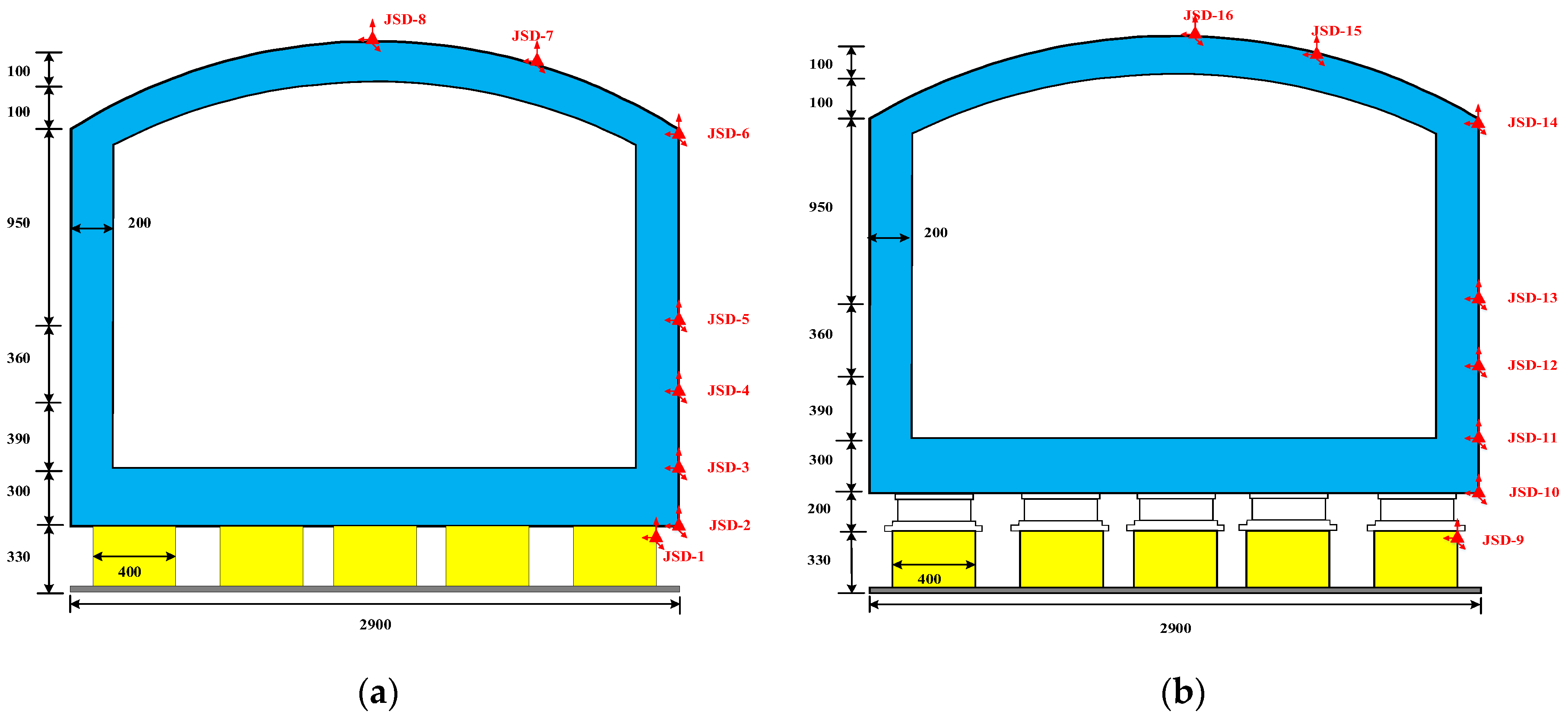

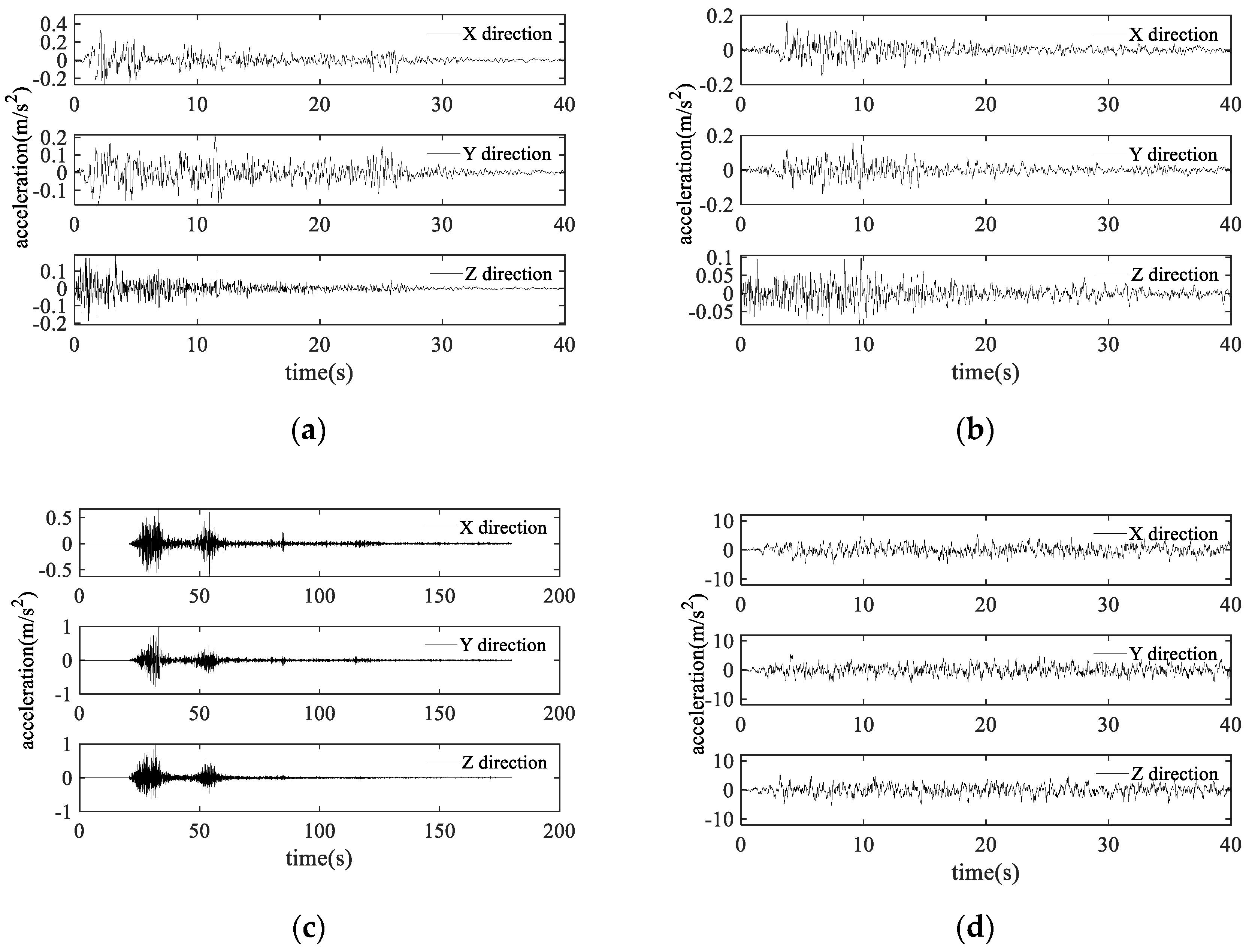
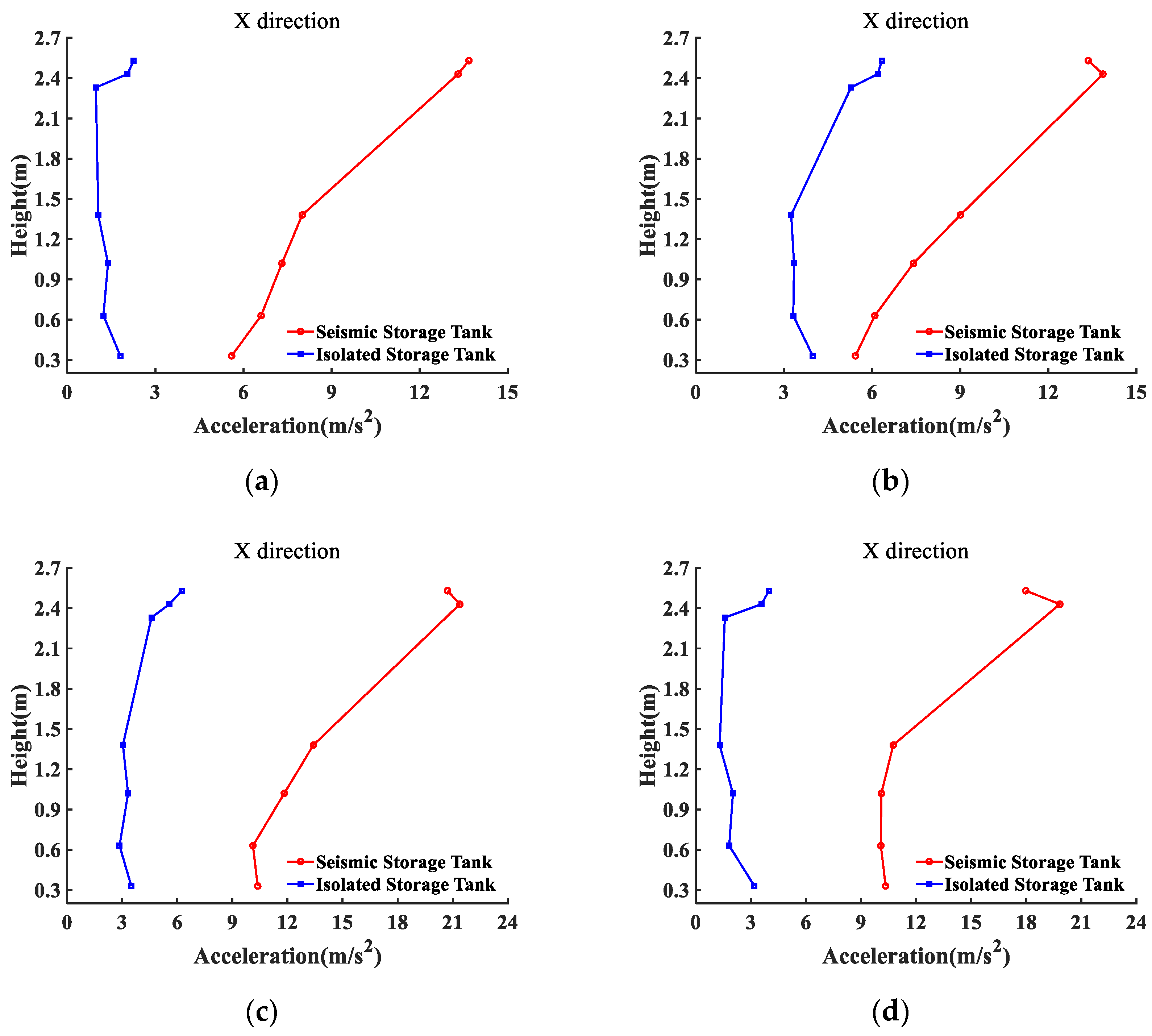
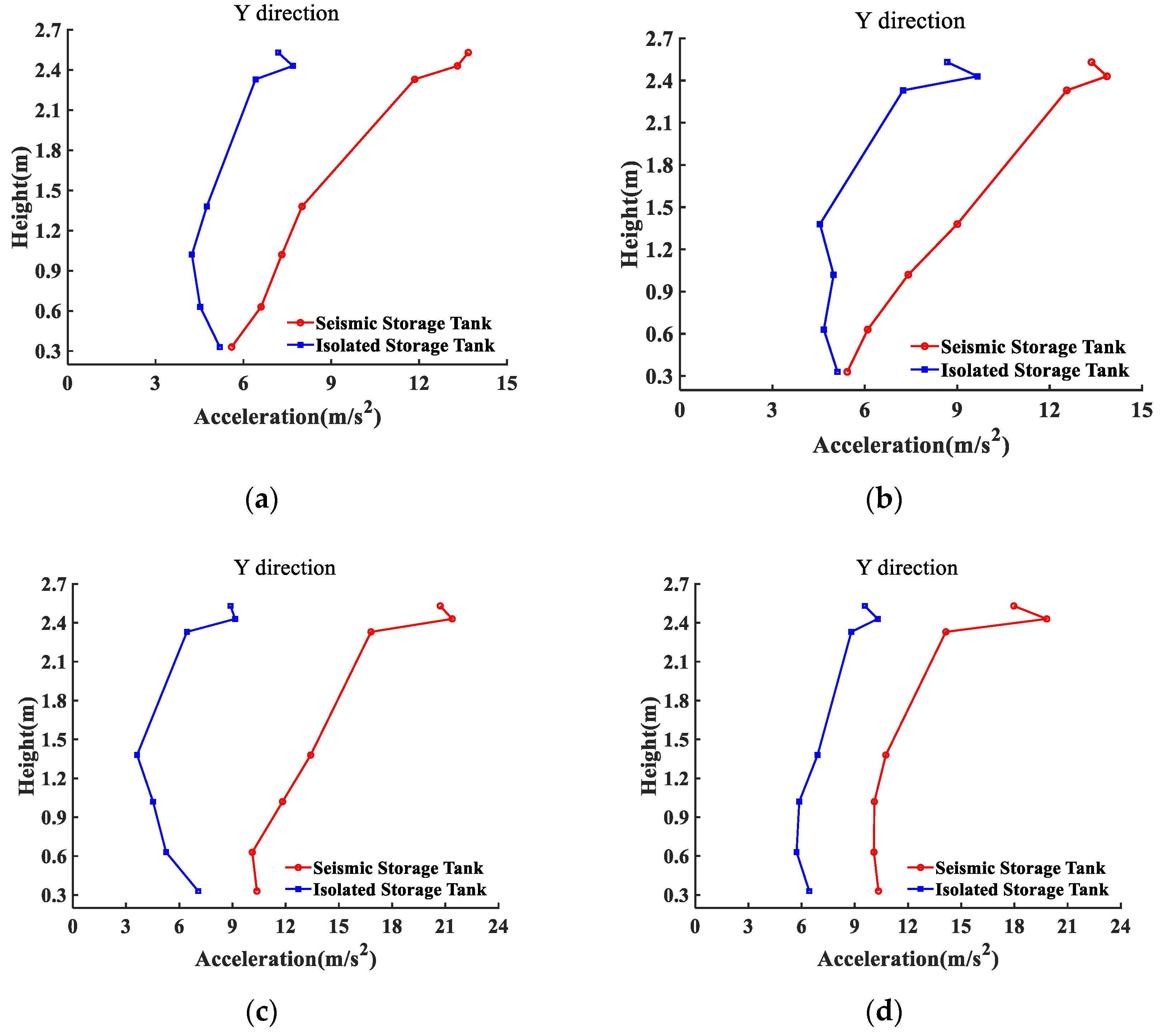
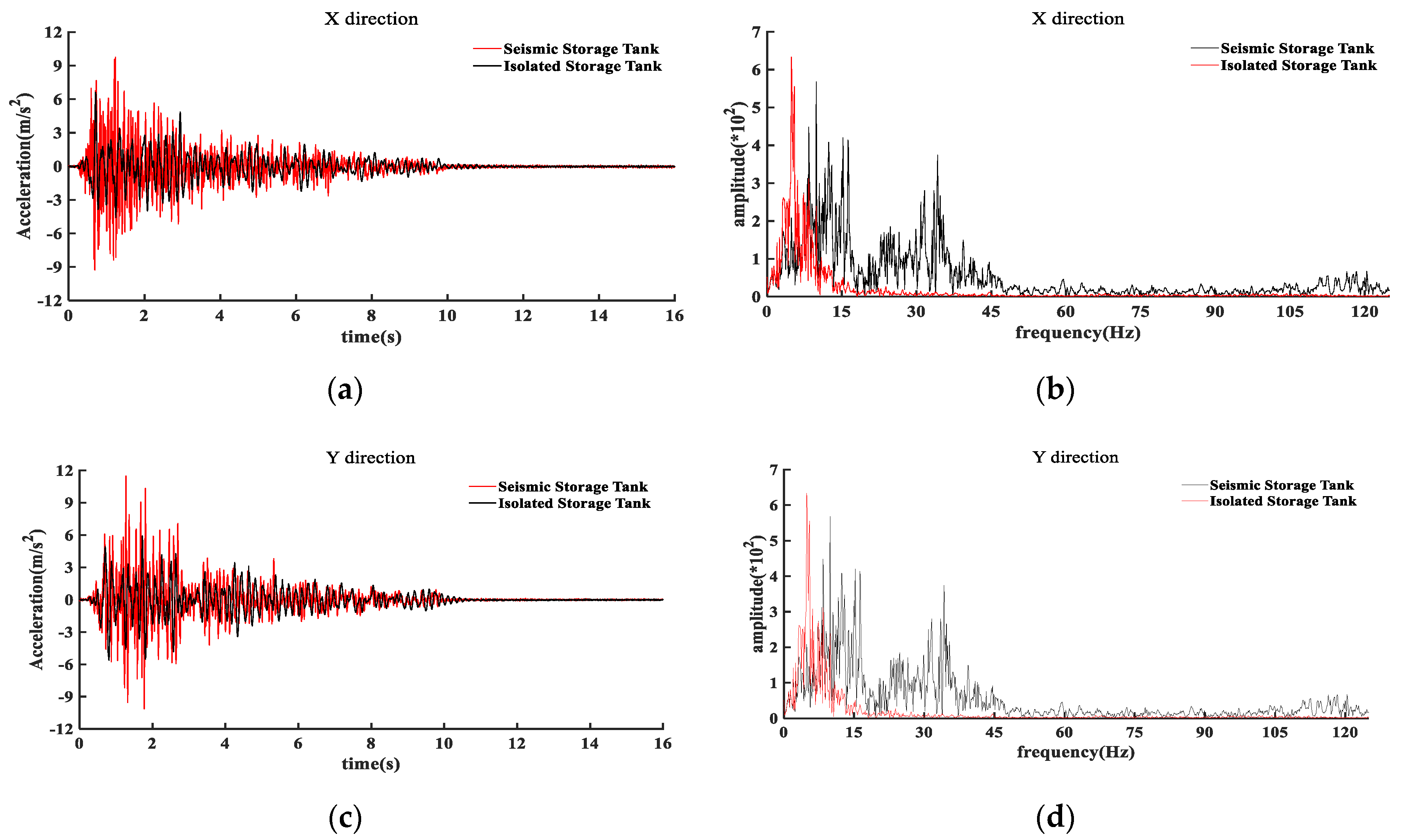
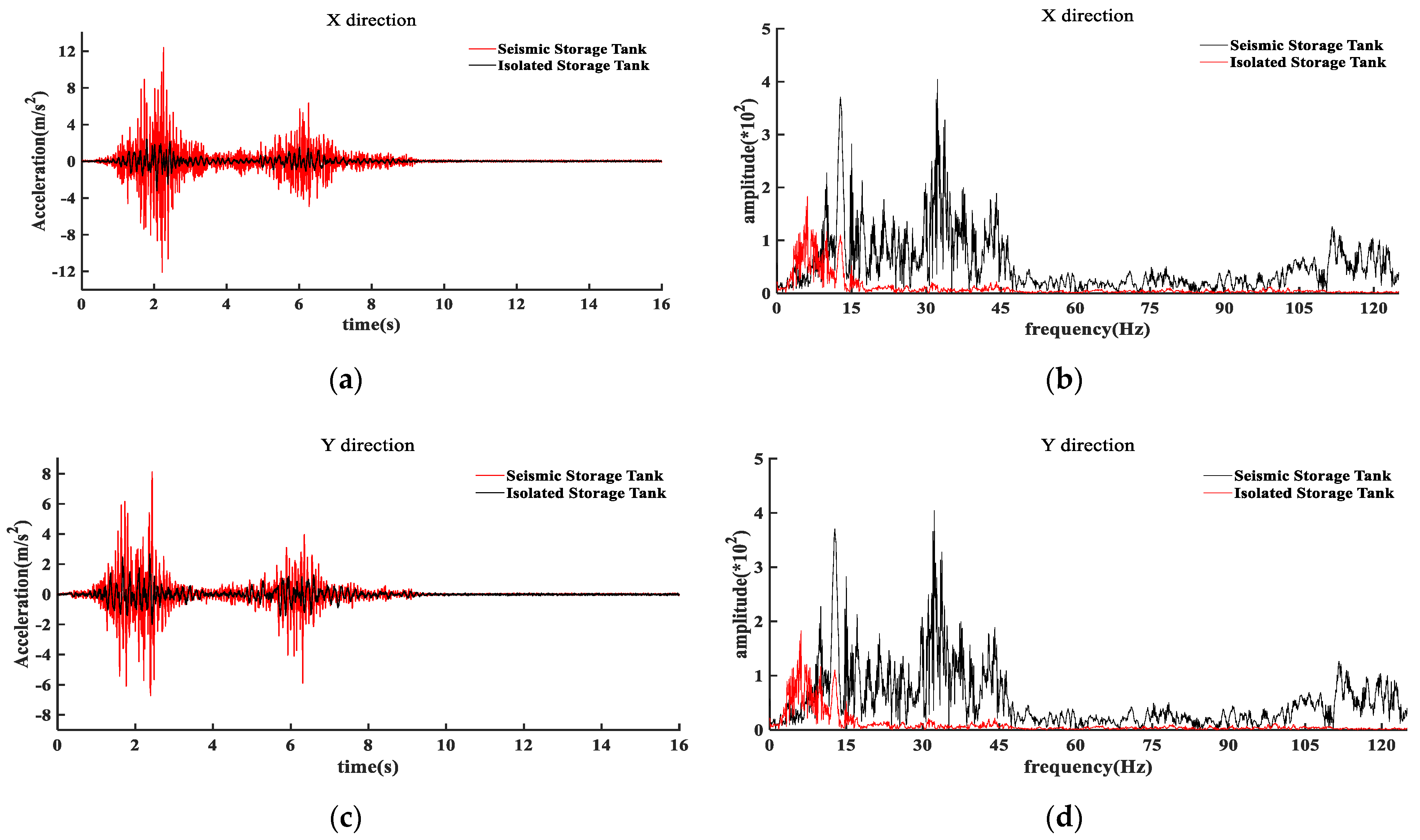
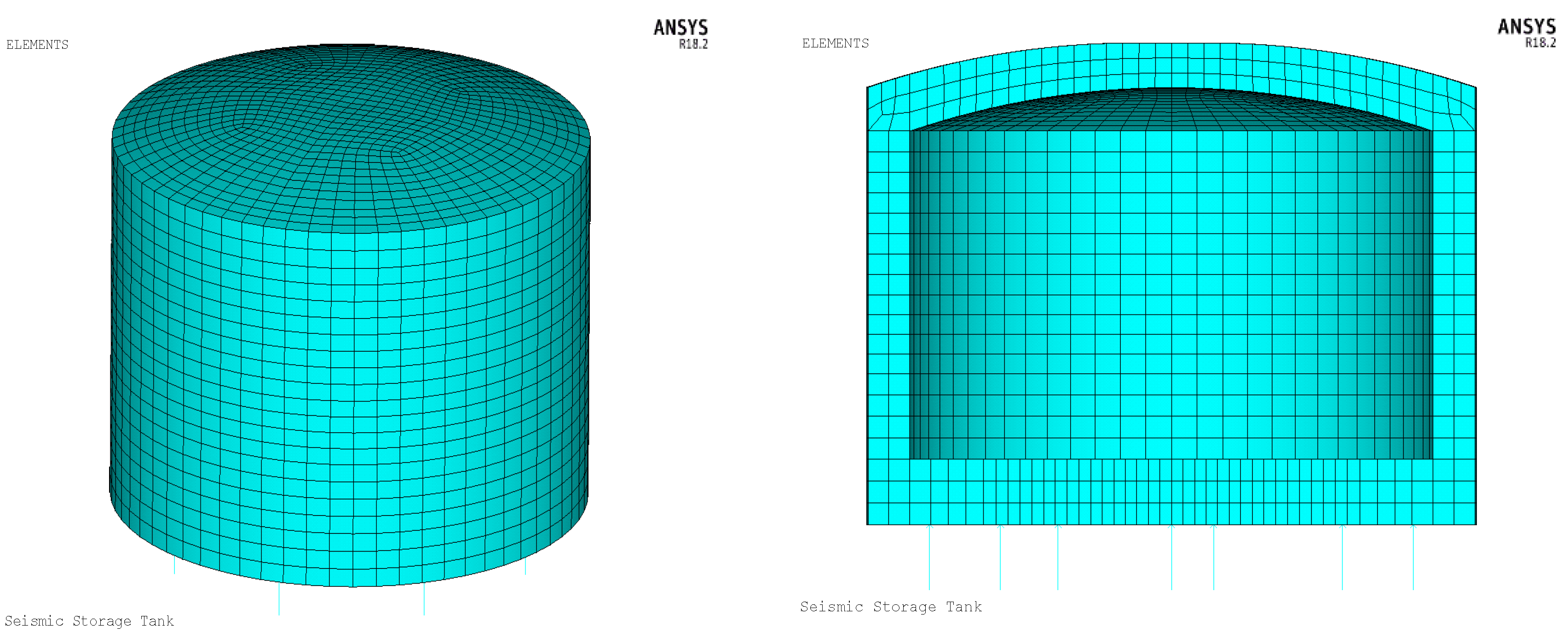
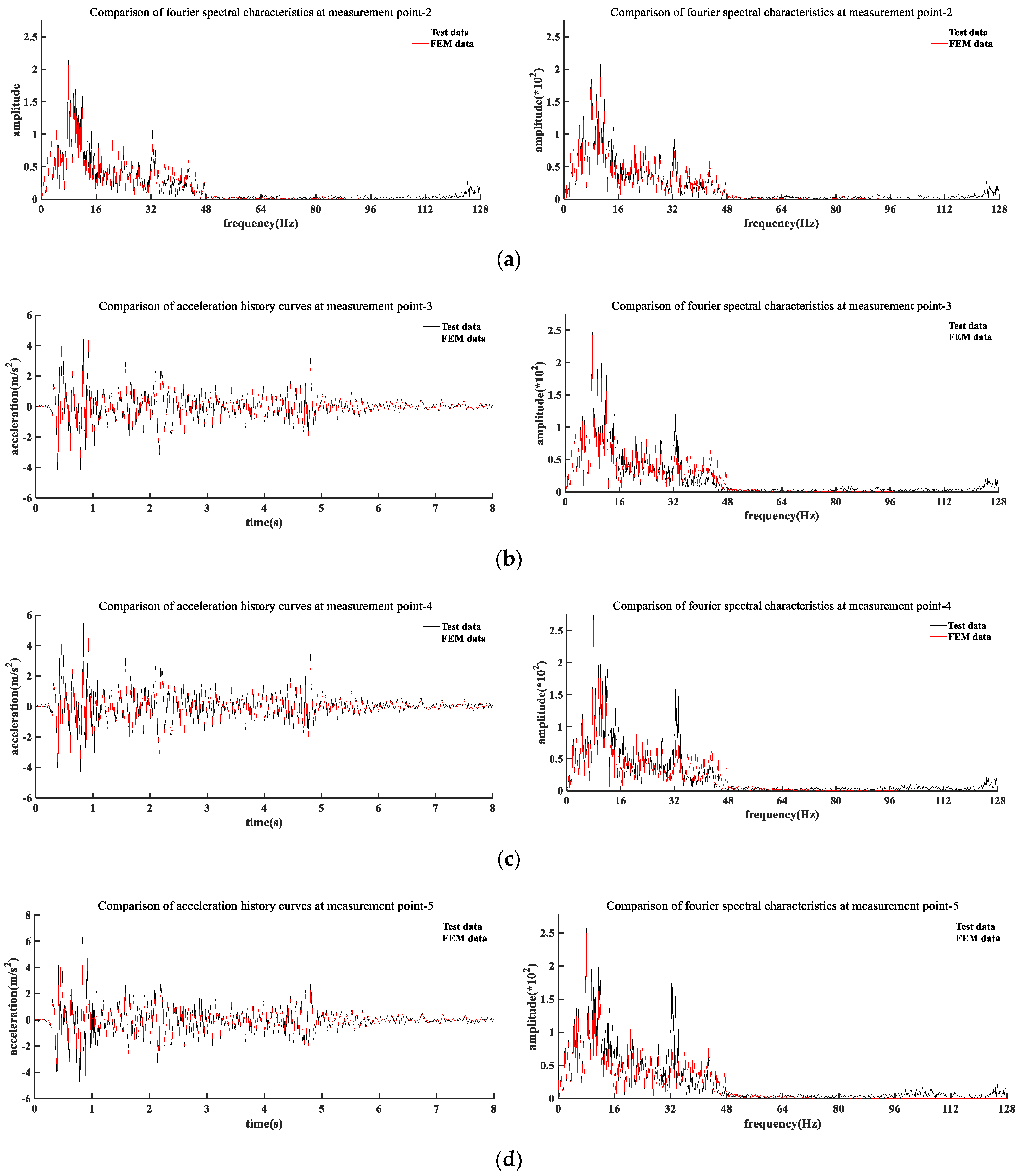
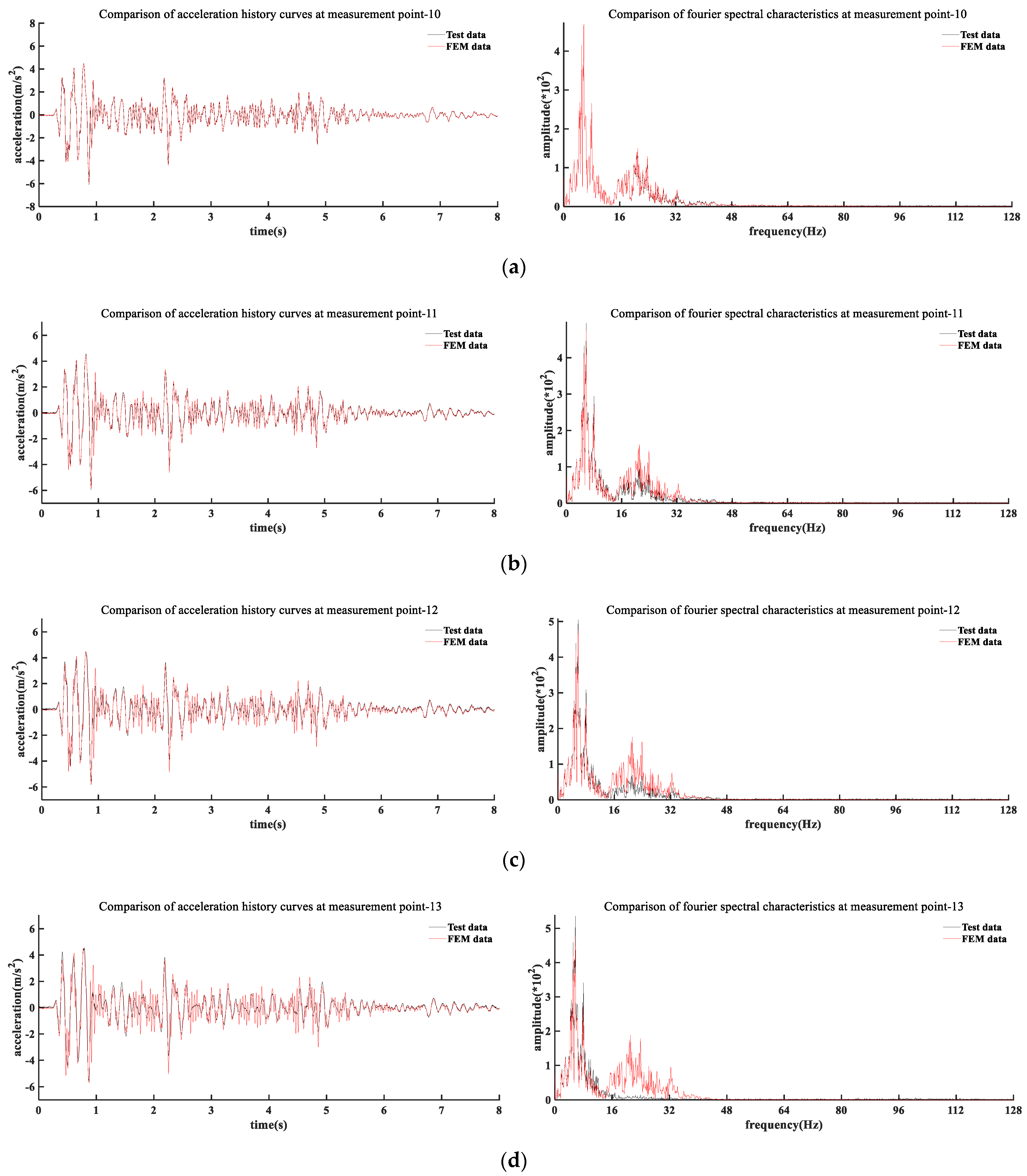

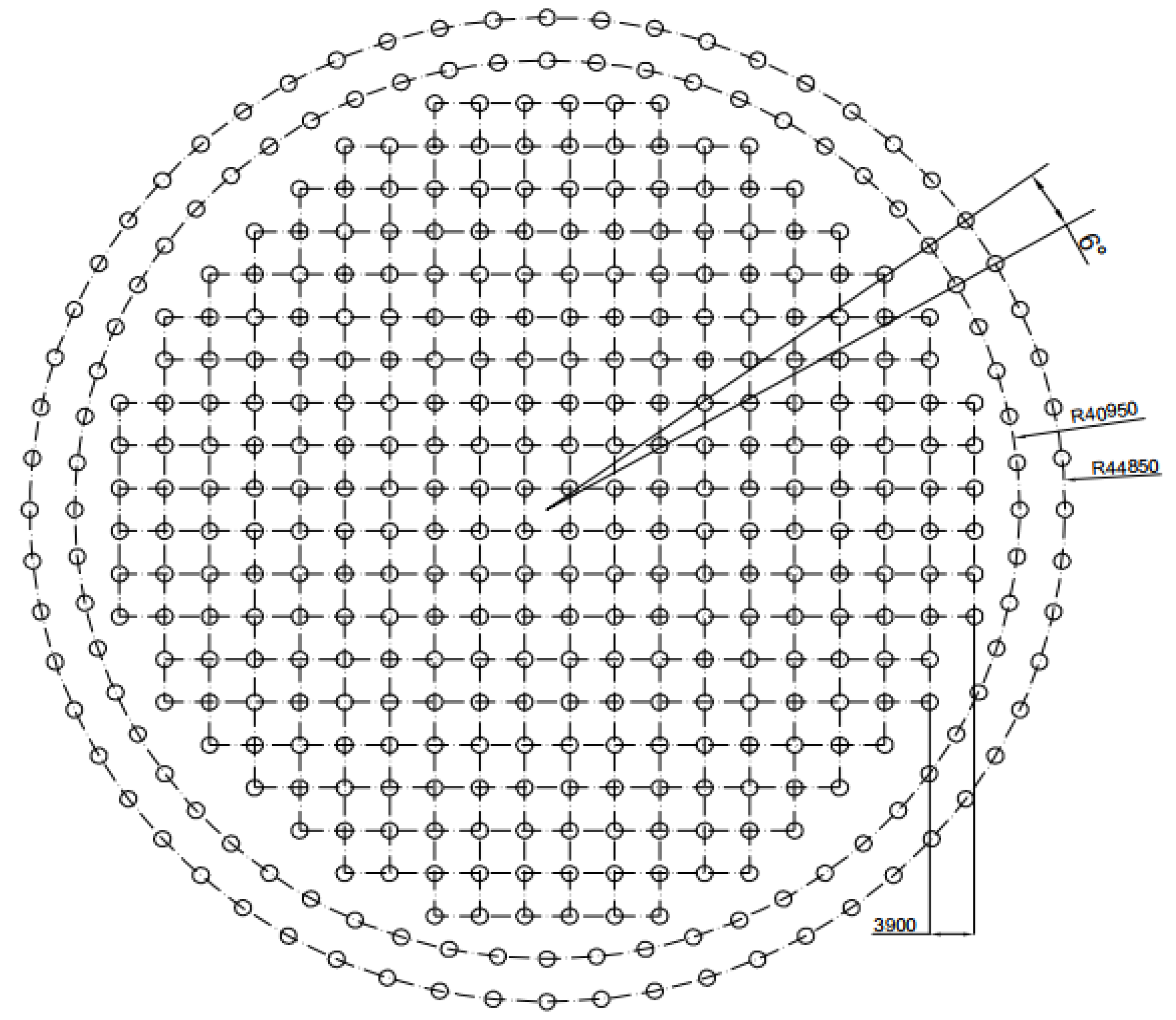
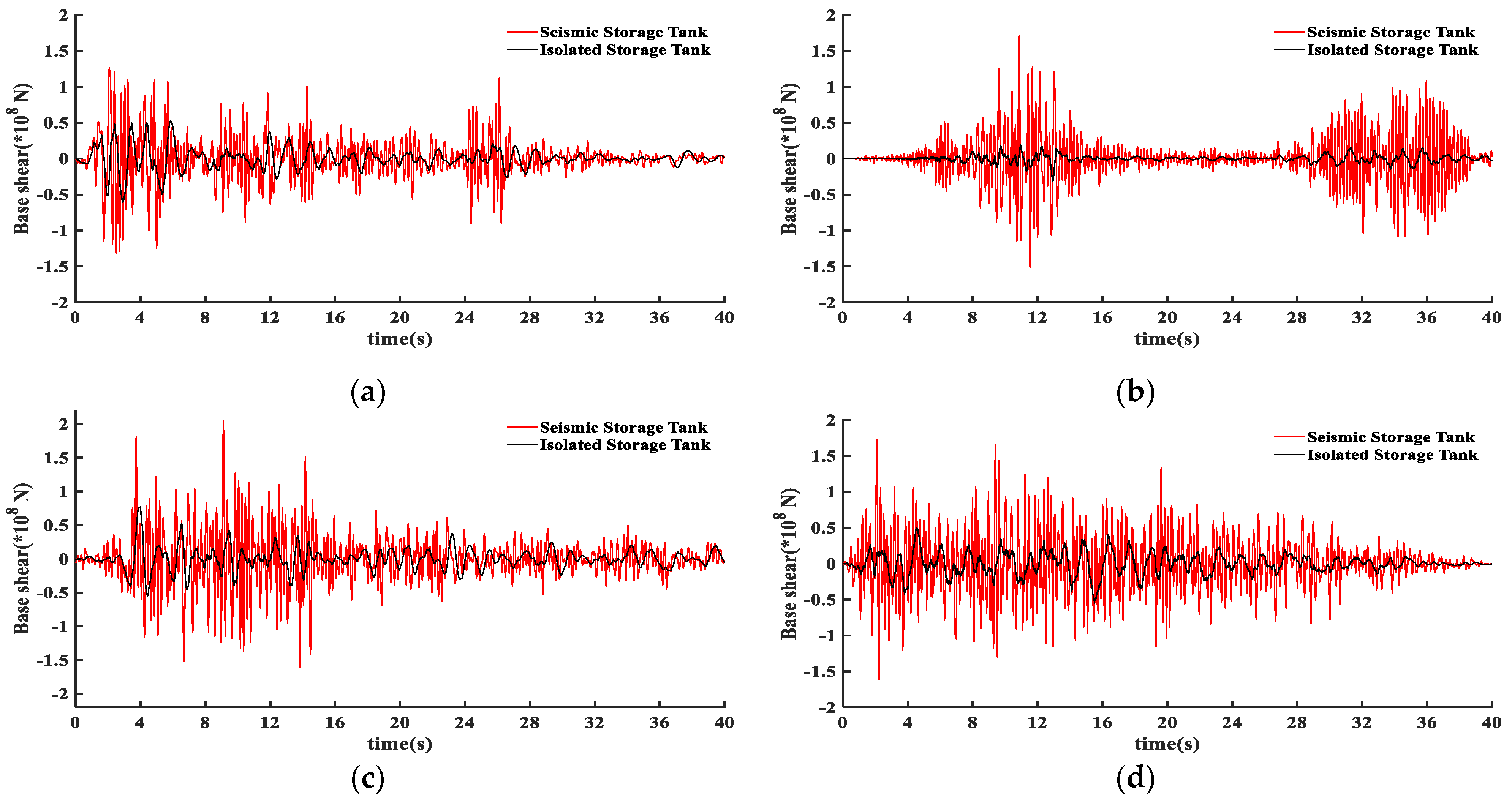

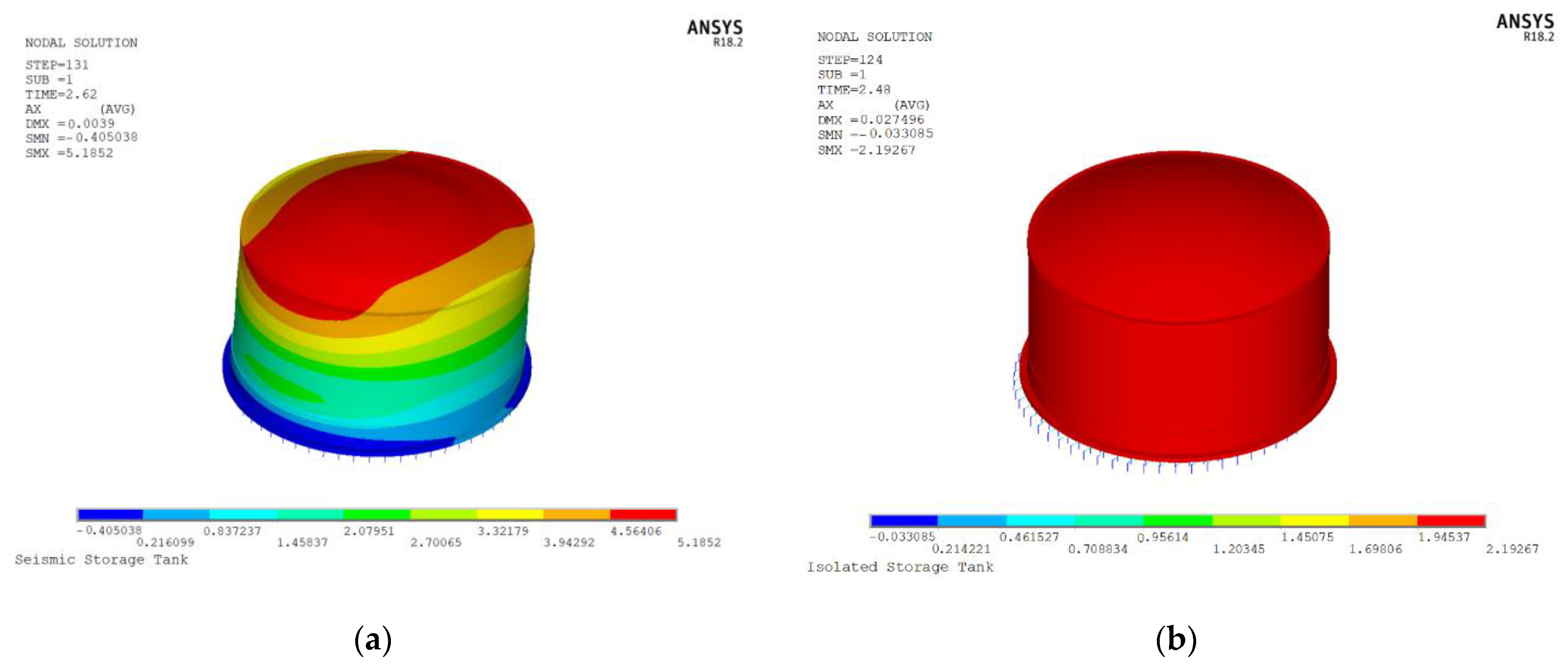

| Condition Number | Test Condition | Excitation Direction | Peak Acceleration (g) |
|---|---|---|---|
| 1 | White noise | X, Y, Z | 0.05 |
| 2–5 | Wolong, Artificial | X, Z; X, Y, Z | 0.1 |
| 6 | White noise | X, Y, Z | 0.05 |
| 7–10 | Wolong, Artificial | X, Z; X, Y, Z | 0.25 |
| 11 | White noise | X, Y, Z | 0.05 |
| 12–21 | El Centro, Taft, Wolong, Artificial | X; X, Z; X, Y, Z | 0.50 |
| 22 | White noise | X, Y, Z | 0.05 |
| 23–34 | El Centro, Taft, Wolong, Artificial | X; X, Z; X, Y, Z | 0.75 |
| 35 | White noise | X, Y, Z | 0.05 |
| Item | Parameter | Item | Parameter |
|---|---|---|---|
| type | LRB300 | height | 150 mm |
| effective outer diameter | 300 mm | shear modulus | 0.392 MPa |
| outer diameter of bearing | 320 mm | rubber standard elastic modulus | 1.5 MPa |
| lead diameter | 60 mm | second shape factor | 5.77 |
| side length of sealing plate | 400 mm | effective area | 70,685.8 mm2 |
| sealing plate thickness | 11 mm | bearing area | 160,000 mm2 |
| rubber layers | 26 layer | hardness correction coefficient | 0.9 |
| layers of sheet steel | 25 layer | vertical stiffness | 887 kN/mm |
| thickness of rubber layer | 3 mm | equivalent horizontal stiffness | 821 kN/m |
| thickness of steel plate | 3 mm | yield force | 22.6 kN |
| total thickness of rubber | 78 mm | post yield stiffness | 469 kN/m |
| total thickness of steel plate | 50 mm | equivalent damping ratio | 30.9% |
| Condition Number | Explanation | Seismic Storage Tank | Isolation Storage Tank | ||
|---|---|---|---|---|---|
| X | Y | X | Y | ||
| 1 | before test | 16.8 | 16.1 | 7.3 | 7.0 |
| 6 | after 0.10 g earthquake | 15.7 | 15.7 | 7.0 | 6.9 |
| 11 | after 0.25 g earthquake | 15.7 | 15.7 | 6.9 | 6.5 |
| 22 | after 0.50 g earthquake | 15.2 | 14.0 | 6.5 | 6.3 |
| 35 | after 0.75 g earthquake | 15.0 | 13.6 | 6.4 | 6.0 |
| Material | Elastic Modulus | Poisson’s Ratio | Density |
|---|---|---|---|
| C40 (outer tank) | 34.5 GPa | 0.167 | 2500 kg/m3 |
| C50 (pile foundation) | 32.5 GPa | 0.167 | 2500 kg/m3 |
| Prestressed steel strand | 195 GPa | 0.3 | 7800 kg/m3 |
| Ordinary reinforced | 200 GPa | 0.3 | 7850 kg/m3 |
| 9% Ni steel | 206 GPa | 0.3 | 7850 kg/m3 |
| Expanded perlite | 0.9 GPa | 0.2 | 120 kg/m3 |
| Foam glass brick | 0.011 GPa | 0.2 | 65 kg/m3 |
| El Centro | Taft | Wolong | Artificial | ||
|---|---|---|---|---|---|
| Base shear force (108 N) | seismic | 1.32 | 2.05 | 1.71 | 1.73 |
| isolation | 0.61 | 0.77 | 0.31 | 0.55 | |
| isolation rate | 53.8% | 62.4% | 81.9% | 68.2% | |
| Overturning bending moment (108 N·m) | seismic | 2.18 | 3.37 | 2.82 | 2.84 |
| isolation | 1.92 | 2.46 | 1.01 | 1.68 | |
| isolation rate | 11.9% | 27.0% | 64.2% | 40.8% | |
| Acceleration of the outer tank wall (m/s2) | seismic | 4.92 | 5.34 | 5.35 | 4.04 |
| isolation | 2.47 | 2.36 | 2.88 | 2.55 | |
| isolation rate | 49.8% | 55.8% | 46.0% | 36.9% | |
| Displacement of the outer tank wall (m) | seismic | 0.0054 | 0.0065 | 0.0059 | 0.0057 |
| isolation | 0.0380 | 0.0322 | 0.0494 | 0.0174 | |
| isolation rate | −604% | −395% | −737% | −205% | |
| Effective dynamic stress of outer tank wall (MPa) | seismic | 0.86 | 1.01 | 1.09 | 0.85 |
| isolation | 0.16 | 0.14 | 0.21 | 0.09 | |
| isolation rate | 81.4% | 86.1% | 80.7% | 89.4% | |
Publisher’s Note: MDPI stays neutral with regard to jurisdictional claims in published maps and institutional affiliations. |
© 2022 by the authors. Licensee MDPI, Basel, Switzerland. This article is an open access article distributed under the terms and conditions of the Creative Commons Attribution (CC BY) license (https://creativecommons.org/licenses/by/4.0/).
Share and Cite
Chen, Z.; Xu, Z.; Teng, L.; Fu, J.; Xu, T.; Zhao, Z. Experimental and Numerical Investigation for Seismic Performance of a Large-Scale LNG Storage Tank Structure Model. Appl. Sci. 2022, 12, 8390. https://doi.org/10.3390/app12178390
Chen Z, Xu Z, Teng L, Fu J, Xu T, Zhao Z. Experimental and Numerical Investigation for Seismic Performance of a Large-Scale LNG Storage Tank Structure Model. Applied Sciences. 2022; 12(17):8390. https://doi.org/10.3390/app12178390
Chicago/Turabian StyleChen, Zengshun, Zhengang Xu, Lingxiao Teng, Jun Fu, Tao Xu, and Zhihang Zhao. 2022. "Experimental and Numerical Investigation for Seismic Performance of a Large-Scale LNG Storage Tank Structure Model" Applied Sciences 12, no. 17: 8390. https://doi.org/10.3390/app12178390
APA StyleChen, Z., Xu, Z., Teng, L., Fu, J., Xu, T., & Zhao, Z. (2022). Experimental and Numerical Investigation for Seismic Performance of a Large-Scale LNG Storage Tank Structure Model. Applied Sciences, 12(17), 8390. https://doi.org/10.3390/app12178390





